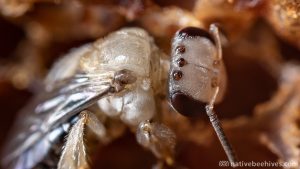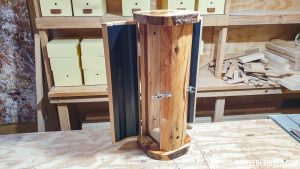I’ve been fine tuning the testing methods over the last couple of years and worked out that to see any differences in results, the box design or construction need to be significantly different. Slight differences in designs aren’t really noticeable. Another important variable is the colony strength. A weak colony could make the box design look bad and a strong colony could make a box look good if you’re not sure how to interpret the data and charts.
The test boxes I’ve settled on here are the 25mm thick hoop pine box which is a light material and the 50mm thick Cypress box being a heavier dense material. These are commonly used box designs with a significant difference so we can see differences in charts.
Photos: Setting up a few boxes with probes
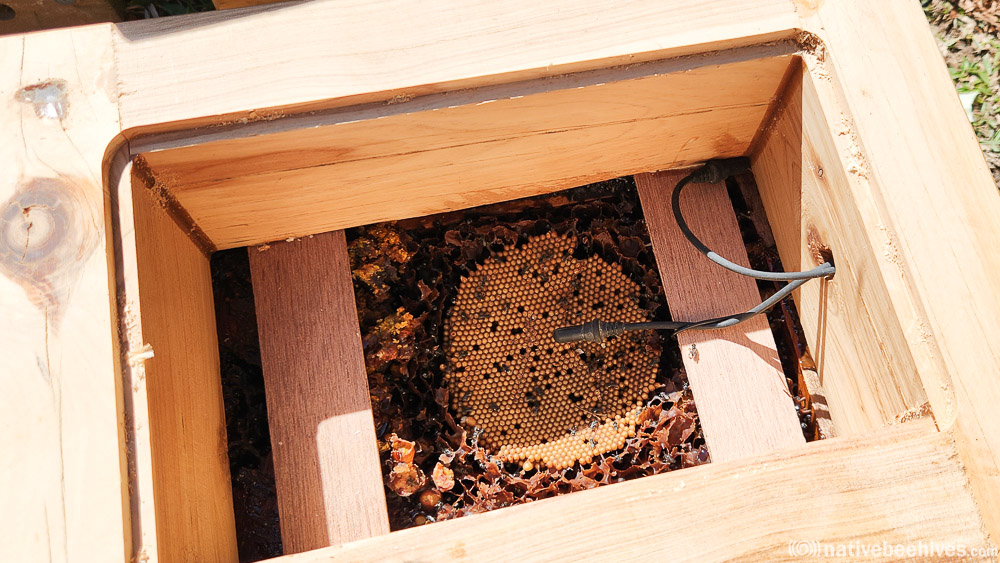


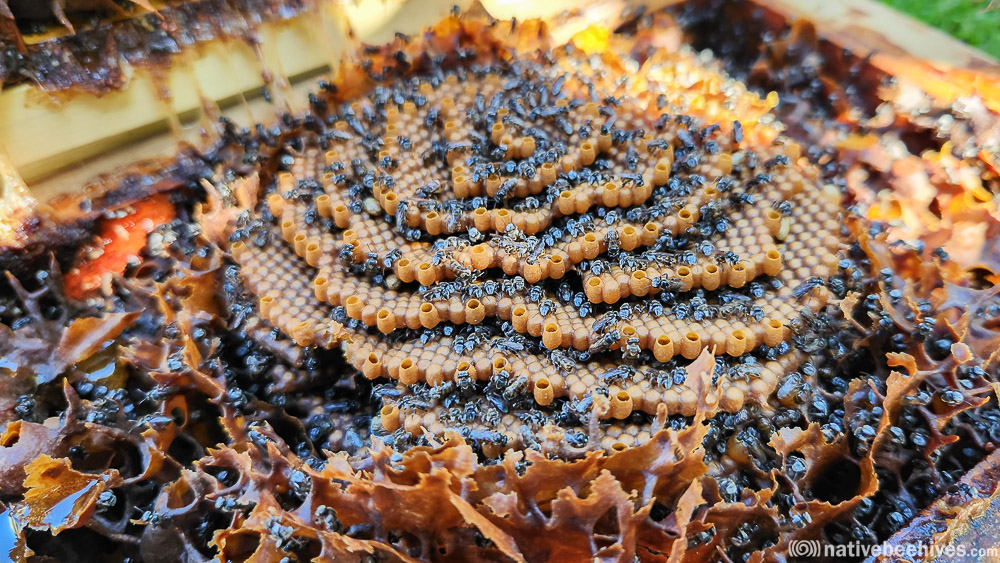
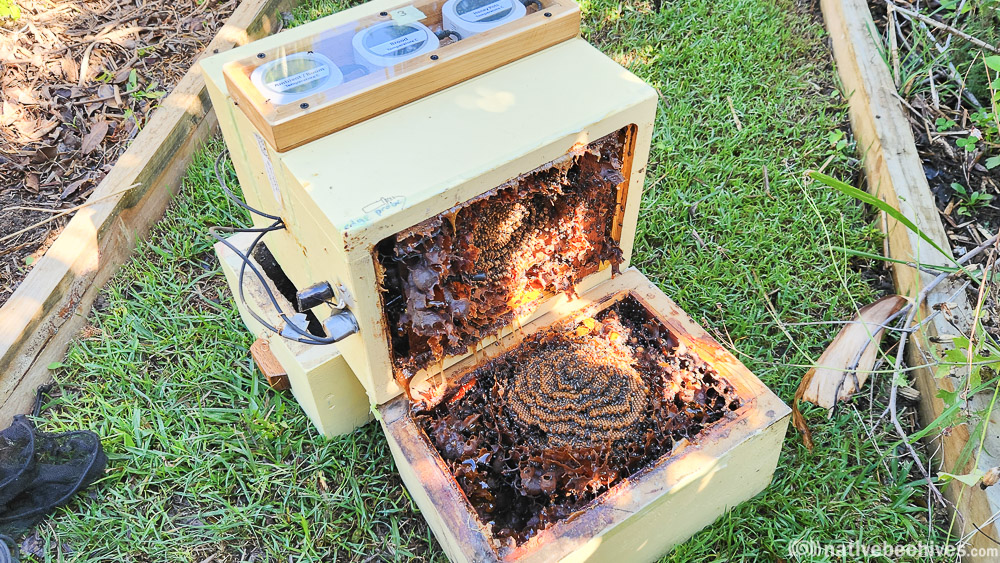
Test: 22 January 2024 – 25mm Hoop Pine Box vs 50mm Cypress
Below: Hive No.2 and No.3. Temperature comparison 25mm Hoop pine box vs 50mm Cypress box. These two boxes are beside each other and get full sun until around 1pm in Summer.

Test: 27 January 2024 – Summer
Image: Surface temperature test. 35°c ambient. 12pm. Left 50mm Cypress box / Right 25mm Painted hoop pine box. The painted hoop pine is 4°c cooler on the front surface of the hive.
The large size number on the display is the result. 40°c for the Cypress and 36.2°c for the yellow painted hoop pine.
Image: Surface temperature on top of the box. Left is the thick plywood “tropical lid” which is quite hot but does provide good protection because it has multiple layers and an air space. Right is the painted hoop pine box. Both boxes will benefit greatly from having good roofs on top.
The large size number on the display is the result. 57.9°c for the darker lid and 50.2°c for the yellow painted hoop pine.
Chart below – Hives without roofs: A hot one in Brisbane. Perfect for temperature testing! Hives in full sun from 8am to 2pm without roofs on boxes with an ambient top of 35°c. Yellow lines: 2x 25mm thick Hoop Pine boxes, Brown lines: 2x 50mm thick Cypress boxes.
The two 25mm Hoop Pine hives are very similar which is good because it’s a consistent result. The two 50mm Cypress hives brood temperatures are fairly different to each other so there could be a difference in probe position or colony strength. The tropical lid would really help keep the heat off the top for the Cypress boxes.
I think the 25mm hoop pine box painted yellow does a pretty good job and surprisingly well without a roof.

June 2024 – Winter
We’ve had poor conditions for bees for a while now with hive owners reporting a few losses. These colonies have been very strong in the past though it looks like they have declined in strength more than usual for this winter. The decline of these test colonies has caused inaccurate results for testing so there has been minimal testing this year.
Photos show how the brood has reduced in size over winter and the probe has ended up outside the brood area giving an inaccurate result. Second photos shows I moved the probe further in to the brood area. This is one of the many challenges that make it very difficult to get an accurate result over a period of time. 1. 50mm cypress box 2. 25mm hoop pine 3. 25mm hoop pine



Chart below shows the 50mm Cypress box. The probe position was corrected. It looks like the bees have accepted the probe in to the brood area and now the minimum temperatures have increased compared to the ambient and honey pot temperatures. An interesting thing is how the honey pot temperatures pretty much follow the ambient for minimum temperatures so there’s minimal insulation from the thick wood and no effort by the bees to create heat outside of the brood. Colony strength is a variable as well.

Chart below:
Comparing the 25mm hoop pine box to the 50mm cypress box over two days. Both colonies have reduced in size over winter and when opened to check the probe positions they appeared to be very similar in strength with a small brood and reduced bee numbers. I don’t think we can pick a winner here for box performance as the temperatures only differ by one or two degrees and have to consider all variables.
Looks like the thermal mass of the 50mm cypress box makes it slower to gain heat and slower to lose it.
On a side note, it’s always good to see the difference between honey pot temperatures and brood, 8 to 10 degrees difference within a distance of 70mm, only separated by the involucrum.

Chart below: 25mm Hoop pine box vs 50mm Cypress box. Both have similarly strength colonies. The colonies have weakened or reduced in size over Winter.
- Both boxes show similar minimum temperatures in the honey pot area.
- The heat in the middle of the day warms the 25mm hoop pine box by one or two degrees in the honey pot area.
- Brood temperatures are similar and differences could be probe position or colony strength.

July 2024 – Winter
18 July 2024: I placed some hives on a property at Nanango Qld. (200 kms north west of Brisbane. 2 ½ hours drive.) Looking at many locations this seemed to be colder than any within a reasonable distance drive. This area is forecast to have temperatures from 1 to -1°c over the next week.
The colony strength and box construction varies between the three hives. This might demonstrate how important colony strength is and maybe the box construction isn’t that critical. As this is an important variable we may have to come up with a “colony strength rating” for the charts.

Chart below: We didn’t get a 0c but a 0.4°c is close enough. Disclaimer: Allow for all variables! It seems almost impossible to have all test colonies at the same strength and all probes in the perfect spot. I’m not seeing any evidence to show that a thick hardwood box would be better than a thinner box.
Observations:
- Weak colony strength combined with the cypress box brood probe possibly out of position, it would be unfair to compare the boxes to each other here.
- A consistent theme though, looking at the honey pot area, the 50mm cypress box gains heat slower and loses heat slower. It’s so slow to gain heat it peaks at a lower temperature during the day compared to the 25mm hoop pine.
- In Winter, More important than box materials, is colony strength, brood and involucrum. If you have a weak colony, the box design may not make much difference at all so colony strength is important. Also see the Foam Covers for insulation test
- Does it matter? If the ambient temperatures are high enough during the day so the bees can get out and forage and have enough resources, does it matter if they get cold at night?

If inside the involucrum got below 17 or 18 degrees then the bees can’t move and generate heat for brood, so it may just be a matter of time at low temps for the brood to be at risk. Looking at the Nanango chart, you can see the 50mm cypress box with the big brood temperature drop. If that’s a weak colony and it doesn’t warm the brood til the sun hits it at 9am, it’d be more at risk than the 16mm PVC box. It was there for a week and is now back at Redcliffe and survived ok.
In Winter, more important than box materials, is colony strength, brood and involucrum. The box design may not make much difference at all. This chart shows four boxes in the rain, from the 12mm ply box with foam cover, 16mm PVC, 25mm Hoop Pine and the 50mm cypress box. The honey pot temperatures are more an indication of box insulation. The only difference I see is thinner boxes change temperature faster but all boxes end up at similar minimums and maximums. I’m yet to see any significant differences between any boxes. The foam cover slows heat loss after a warm day but during the couple days of rain it ended up at the same temperature as the others. The hot box hive looks warmer for the rainy days but I think that requires more testing with different hives.








